MyDigitalSSD SMART & BP3 mSATA SSD Review
by Kristian Vättö on January 22, 2013 1:24 PM ESTMyDigitalSSD SMART
The heart of the SMART is SandForce's SF-2281 controller, which is used by dozens of manufacturers. SandForce doesn't use dedicated DRAM cache, leaving the controller and NAND as the only components on the PCB. The drive came with firmware 5.0.2a but there's a newer 5.0.4 available at MyDigitalSSD's website. I ran a few tests with the new firmware but didn't see any noticeable difference in performance so the scores you'll see are with the 5.0.2a firmware.
On the flip side we find another two NAND packages. These are all octo-die packages to yield the capacity of 256GB, which is currently the maximum for mSATA form factor (though Mushkin has announced a stacked mSATA design with up to 480GB). Once 128Gb dies start to make their way into the market sometime in 2013, we should see mSATA SSDs of up to 512GB without special designs.
The actual NAND in the SMART is a bit of a mystery. Googling the part number yields no results but from what I was able to find, it seems that the NAND is running in synchronous mode and manufactured using IMFT's 25nm process but packaged by ADATA (for example their SX300 uses the same NAND). The idea is that you buy whole wafers of NAND and then use your own binning methodology to pick the best dies. When you buy pre-packaged NAND, it's unlikely that you'll be getting the highest quality NAND because usually the manufacturer reserves that NAND for their own products. If you buy NAND in whole wafers, you will also get a small share of the highest quality chips, although you are also left with a big chunk of NAND that is not suitable for SSDs (but it may be fine for memory sticks and cards). This is a fairly common practice in the SSD industry and for example OCZ and Kingston do it as well.
It's unclear to me why MyDigitalSSD chose ADATA but the SMART is actually recognized as an ADATA SX300 by the system, so the SMART may be a rebrand of the SX300 or at least MyDigitalSSD has worked very closely with ADATA.
MyDigitalSSD BP3
Not much is known about Phison's PS3108 controller. Phison says the controller supports both SLC and MLC NAND, along with 1Xnm class NAND. The controller is fabricated using 55nm CMOS process, but the actual manufacturer is unknown. The controller is coupled with 256MB of DDR3-1333 DRAM from Nanya. The drive came with firmware version 3.2, which is currently the latest.
In the NAND department we have four of Toshiba's 24nm Togge-Mode MLC NAND packages, each consisting of eight 8GB dies yielding a total capacity of 64GB per package.
The motherboard in my testbed does not have an mSATA slot, so MyDigitalSSD also sent us an mSATA to 2.5" SATA adapter.
Test System
| CPU | Intel Core i5-2500K running at 3.3GHz (Turbo and EIST enabled) |
| Motherboard | AsRock Z68 Pro3 |
| Chipset | Intel Z68 |
| Chipset Drivers | Intel 9.1.1.1015 + Intel RST 10.2 |
| Memory | G.Skill RipjawsX DDR3-1600 2 x 4GB (9-9-9-24) |
| Video Card |
XFX AMD Radeon HD 6850 XXX (800MHz core clock; 4.2GHz GDDR5 effective) |
| Video Drivers | AMD Catalyst 10.1 |
| Desktop Resolution | 1920 x 1080 |
| OS | Windows 7 x64 |


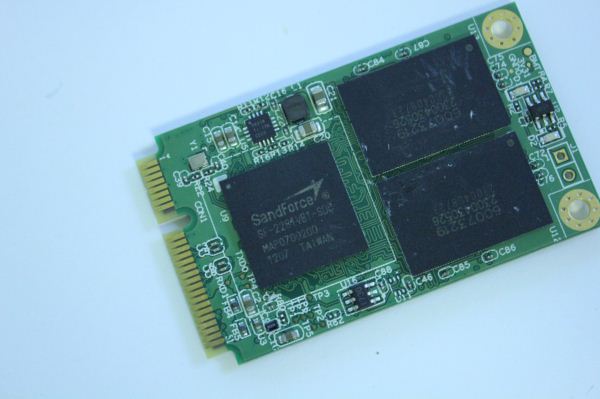
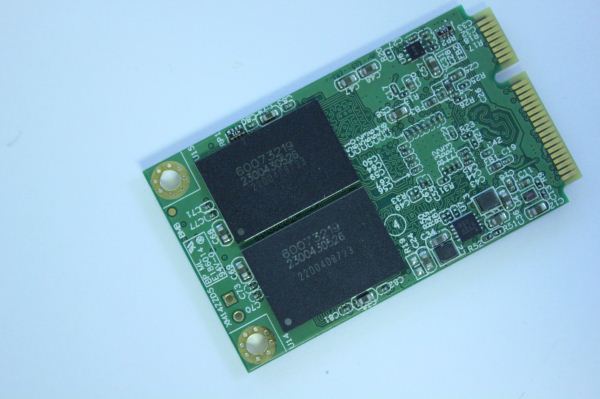
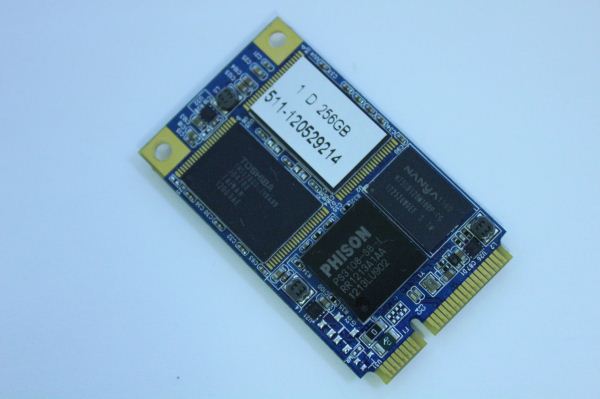
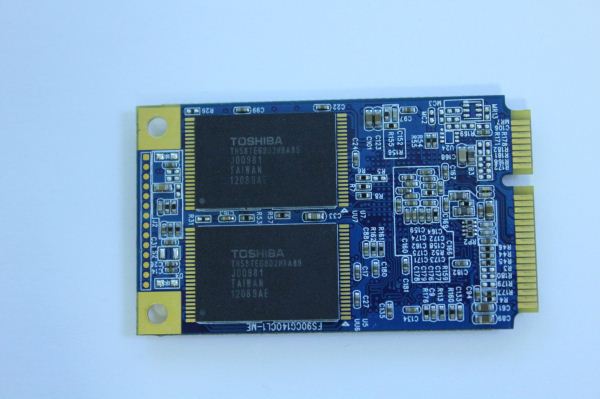
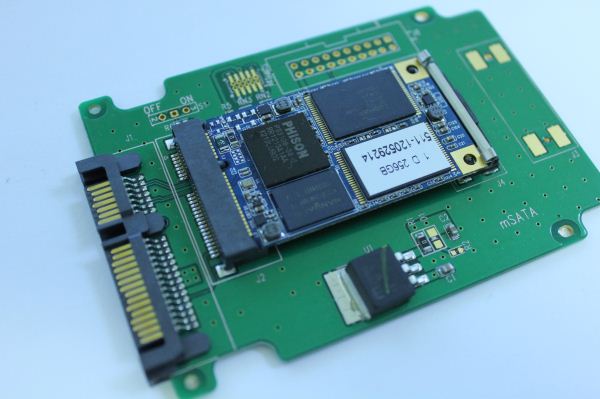








49 Comments
View All Comments
Flunk - Tuesday, January 22, 2013 - link
DIY upgrades are really what mSATA SSDs are for. They really don't make sense on the desktop. But I would argue that the performance desktop is just as much a niche market. As long as a market exists these products will too.As for me I have a ADATA SX300 mSATA SSD (256GB) along with a 750GB HD in an Alienware m14x R2. Great way to get more storage into a system that couldn't fit another 2.5" drive without losing the optical bay. mSATA SSDs are very convenient now.
Hopefully everyone will standardize on one of the new PCI-E based SSD specs, but that's all future technology for now.
Kraszmyl - Tuesday, January 22, 2013 - link
Considering almost all of dell and lenovos machines that came out recently have msata slots i wouldnt exactly call them rare and im sure the ultrabook people will move to them too.That being said i would like to see them on more itx and micro atx boards.
ssj3gohan - Tuesday, January 22, 2013 - link
Yeah, I'm super-happy with the mSATA slots on recent Intel mITX and mATX motherboards. It may seem like a small deal to some, but mSATA saves a lot of space and IMO more importantly: a mess of wires.I've been able to build very capable systems with no wires blocking airflow and getting in the way at all in arguably the smallest enclosure commercially available, the mini-box M350. All because of motherboards supporting 19V input and mSATA.
JarredWalton - Tuesday, January 22, 2013 - link
mSATA is already being phased out for NGFF/M.2, so I don't expect a lot of support for mSATA going forward. Apple, ASUS, and others already skipped mSATA to go their own routes, indicating the perceived issues from those manufacturers.M.2 will hopefully bring more standardization and acceptance, and it would be great if ASUS, Apple, etc. used M.2 instead of proprietary connectors -- there are quite a few people that are ticked that UX21A/UX31A had review samples with SF-2281 ADATA drives and then shipping consumer models typically (maybe even only?) used SanDisk U100. Because of the proprietary connector, there's basically no way to upgrade from the U100.
ssj3gohan - Wednesday, January 23, 2013 - link
I don't necessarily care whether it's NGFF or mSATA, as long as it's a cableless solution and there's sufficient availability of drives. Right now mSATA has good market penetration; I haven't had any problems sourcing tens of crucial m4 mSATA drives, even the most exotic 256GB variant. Same goes for myDigitalSSD's earlier offerings, which seemed to be in stock all the time (very short lead times).As soon as NGFF is used or can be used on the desktop I'm perfectly happy using those as the ubiquitous boot drive.
Voldenuit - Tuesday, January 22, 2013 - link
Exactly!mSATA SSDs are a good way to add performance and capacity to a (compatible) laptop. And doing it aftermarket keeps the OEMs from ripping off the customer with their exorbitant upgrade prices.
I added a 128 GB crucial m4 SSD to my wife's Thinkpad X230T laptop to complement the existing 500GB hdd. It was far cheaper than configuring it with a 2.5" SSD from lenovo (there was no option on their configurator to outlay the laptop with a mSATA SSD instead) and far more versatile, as the single-spindle X230T is now transformed into effectively a 2-spindle machine (still no DVD drive, but we have an ultrabase mobile dock for that).
I wouldn't buy a modern laptop that doesn't have an mSATA slot today.
cmikeh2 - Tuesday, January 22, 2013 - link
While traditional forms of computing may not necessitate the smaller form factor future products like Intel's Next Unit of Computing with its 4 x 4 inch mobo only supports mSATA. Work in this form factor will allow products like NUC to be worthwhile.digitalzombie - Tuesday, January 22, 2013 - link
"the potential to grap a large share"grap -> grab
Kristian Vättö - Tuesday, January 22, 2013 - link
Thanks for the heads up, fixed! :-)kesh - Tuesday, January 22, 2013 - link
Just a guess, but wouldn't there be a market for mSATA in embedded computing world?I have an ongoing project of turning a broken (slim) CD player to a digital audio player, which has been going slow over a last few years, and when I first saw mSATA, I immediately thought it as the perfect storage solution for my project.